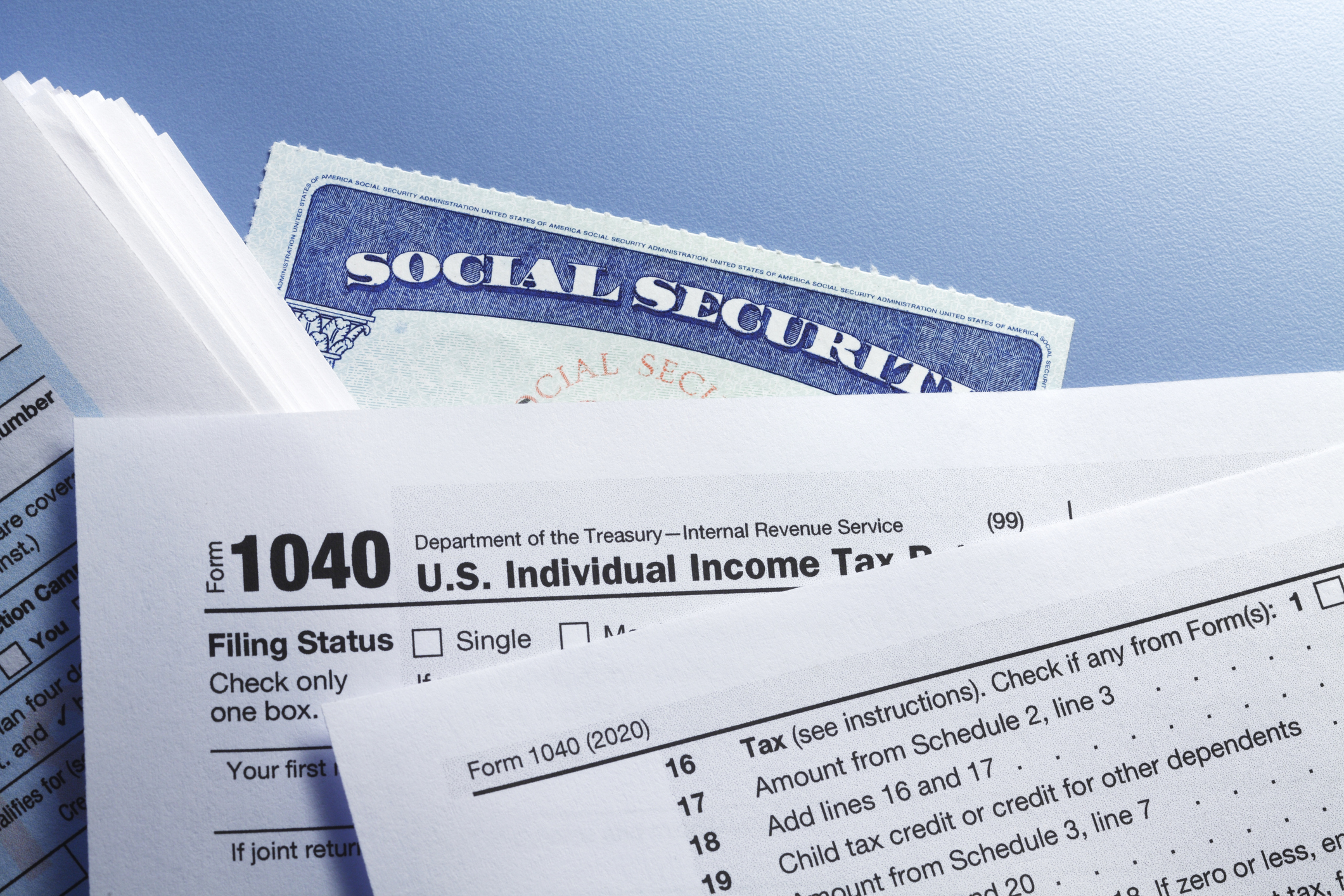How to Calculate Taxes on Social Security Benefits in 2025
The federal government can tax up to 85% of your Social Security benefits, so it's good to know how those taxes are calculated.


It may come as a surprise, but Social Security benefits are not entirely tax-free. Depending on your income, up to 85% of your Social Security benefits can be subject to tax. That includes retirement and benefits from Social Security trust funds, like survivor and disability benefits, but not Supplemental Security Income (SSI).
The chance of paying taxes on your Social Security benefits is higher when you have significant taxable income from a job, pension, or traditional IRA, for example.
However, many people who only have income from Social Security don’t pay income taxes on their benefits at the federal level.

Sign up for Kiplinger’s Free E-Newsletters
Profit and prosper with the best of expert advice on investing, taxes, retirement, personal finance and more - straight to your e-mail.
Profit and prosper with the best of expert advice - straight to your e-mail.
Still, since like other forms of retirement income taxed by the IRS, taxes on Social Security benefits are a possibility for retirees, it’s important to know how Social Security taxes are calculated.
Related: At What Age Are Social Security Benefits No Longer Taxed?
How to calculate tax on Social Security benefits
Each January, after you begin receiving Social Security benefits, you will receive a statement (Form SSA-1099) showing the total benefits you received in the previous year.
When determining how much you may be taxed, the first step is to calculate your "combined income."
The IRS says your combined income is your adjusted gross income (AGI) plus nontaxable interest and half of your Social Security benefits from the year. You then take away certain deductions and exclusions.
The following tiered system determines the percentage of your benefits that are taxable.
- If your combined income is under $25,000 (single) or $32,000 (joint filing), there is no tax on your Social Security benefits.
- For combined income between $25,000 and $34,000 (single) or $32,000 and $44,000 (joint filing), up to 50% of benefits can be taxed.
- With combined income above $34,000 (single) or above $44,000 (joint filing), up to 85% of benefits can be taxed.
If you need clarification on whether your Social Security benefits are taxable, the IRS has a tool on its website that can help.
Once you know how much of your benefits are taxable, you must include that amount on Line 6b of Form 1040.
That income will be taxable, along with any other income, based on your tax bracket and the income tax rate tied to it.
Tax on lump-sum payment from Social Security
When calculating taxes on your Social Security benefits, you should include the taxable portion of any lump-sum payment you received during the year. (That is true even if that payment includes benefits from a previous year.)
However, the inclusion might lower the taxable portion of your benefits. In that case, the IRS says you can elect to figure the taxable part of a lump-sum payment for an earlier year separately, using your income for the previous year.
Note: Lump-sum retirement benefits differ from lump-sum death benefits. It's important to note that no part of a lump-sum death benefit paid by the Social Security Administration (SSA) is taxable.
How to withhold taxes from Social Security payments
It's important to plan if you know some of your Social Security benefits will be taxed. To avoid surprises, you can request that federal income taxes be withheld from your monthly payments.
- To do this, you must fill out Form W-4V and submit it to your local Social Security office.
- You can choose a withholding rate of 7%, 10%, 12%, or 22%.
- Withholding taxes from your Social Security payments is one way to cover your potential tax liability before Tax Day arrives.
If you prefer not to have taxes deducted from your monthly Social Security payments, you can make quarterly estimated tax payments. Regardless of the method, the goal is to ensure you have paid enough tax to avoid an underpayment penalty from the IRS when you file your income tax return.
State tax on Social Security benefits
In addition to federal taxes, some states tax Social Security benefits. However, the methods and extent of taxation vary.
For example, New Mexico technically taxes Social Security benefits, but many retirees will not pay a dime to the state on that income at tax time. That’s because recently passed state legislation provides higher income thresholds in New Mexico for exempting Social Security benefits.
Also, West Virginia is completely phasing out its tax on Social Security benefits by 2026. The move, initiated by legislation passed in March 2024, represents a significant policy shift. Some proponents say it will make West Virginia more attractive to retirees and ease the financial burden on its aging population.
(For more information, see Taxes on Social Security: Two States Make Big Changes for 2025.)
Although you cannot have state taxes withheld from Social Security benefits, you might be able to make estimated state tax payments.
Contact your state Department of Revenue for information about your state's estimated tax payment rules.
Related Content
Profit and prosper with the best of Kiplinger's advice on investing, taxes, retirement, personal finance and much more. Delivered daily. Enter your email in the box and click Sign Me Up.

As the senior tax editor at Kiplinger.com, Kelley R. Taylor simplifies federal and state tax information, news, and developments to help empower readers. Kelley has over two decades of experience advising on and covering education, law, finance, and tax as a corporate attorney and business journalist.
-
 Here's Why Walmart Deals are Better Than Amazon Prime Day
Here's Why Walmart Deals are Better Than Amazon Prime DayWith sales for Walmart Deals and Amazon Prime Day running comparable on price, one factor separates them.
-
 How to Get Rid of the Things Your Kids Don't Want While Downsizing
How to Get Rid of the Things Your Kids Don't Want While DownsizingWhether moving by necessity or choice, downsizing means deciding what to do with your stuff. Here's what to do if the kids and grandkids don't want it all.
-
 Ten Cheapest Places to Live in Virginia
Ten Cheapest Places to Live in VirginiaProperty Taxes The Commonwealth of Virginia has some cheap places to live. Here are a few if you hate paying property taxes.
-
 2025 SALT Cap Could Hurt Top 'Hidden Home Cost'
2025 SALT Cap Could Hurt Top 'Hidden Home Cost'Tax Deductions The GOP tax bill could make hidden homeowner costs worse for you. Here’s how.
-
 Retire in the Bahamas With These Three Tax Benefits
Retire in the Bahamas With These Three Tax BenefitsRetirement Taxes Retirement in the Bahamas may be worth considering for high-net-worth individuals who hate paying taxes on income and capital gains.
-
 2025 Virginia Tax Rebate Checks Coming Soon? What to Know Now
2025 Virginia Tax Rebate Checks Coming Soon? What to Know NowTax Rebates Given a historic 2025 gubernatorial race, tax policy will remain a key issue for Virginians in the months ahead.
-
 Summer Backyard Ideas With Added Tax Benefits for 2025
Summer Backyard Ideas With Added Tax Benefits for 2025Tax Tips Find out how these summer 2025 home projects can help you save on taxes next year.
-
 Coverdell ESAs vs. 529 Plans: Which Should You Choose?
Coverdell ESAs vs. 529 Plans: Which Should You Choose?Savings Accounts These savings accounts can offer tax benefits for school and retirement expenses. Here’s how.
-
 Homeschoolers Could Soon Save on Expenses With 529 Plans
Homeschoolers Could Soon Save on Expenses With 529 PlansSavings Accounts A new House GOP bill could change how you save for your child's homeschool education. Find out how.
-
 Five ‘Big Beautiful Bill’ Tax Changes to Watch in the Senate
Five ‘Big Beautiful Bill’ Tax Changes to Watch in the SenateTax Policy The House passed its version of Trump’s "One Big, Beautiful Bill." Here’s what to look for as Senate Republicans take up the mega legislation.